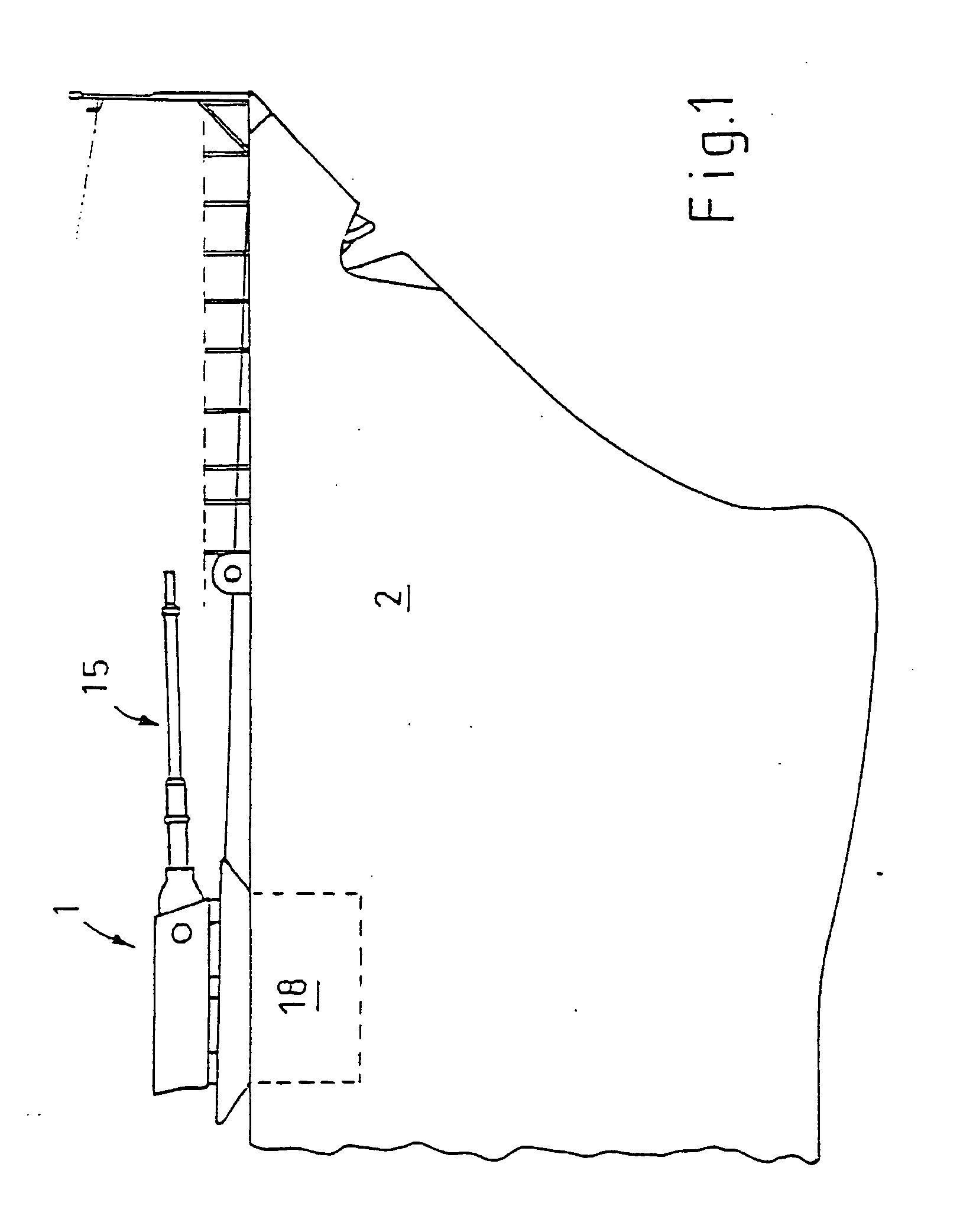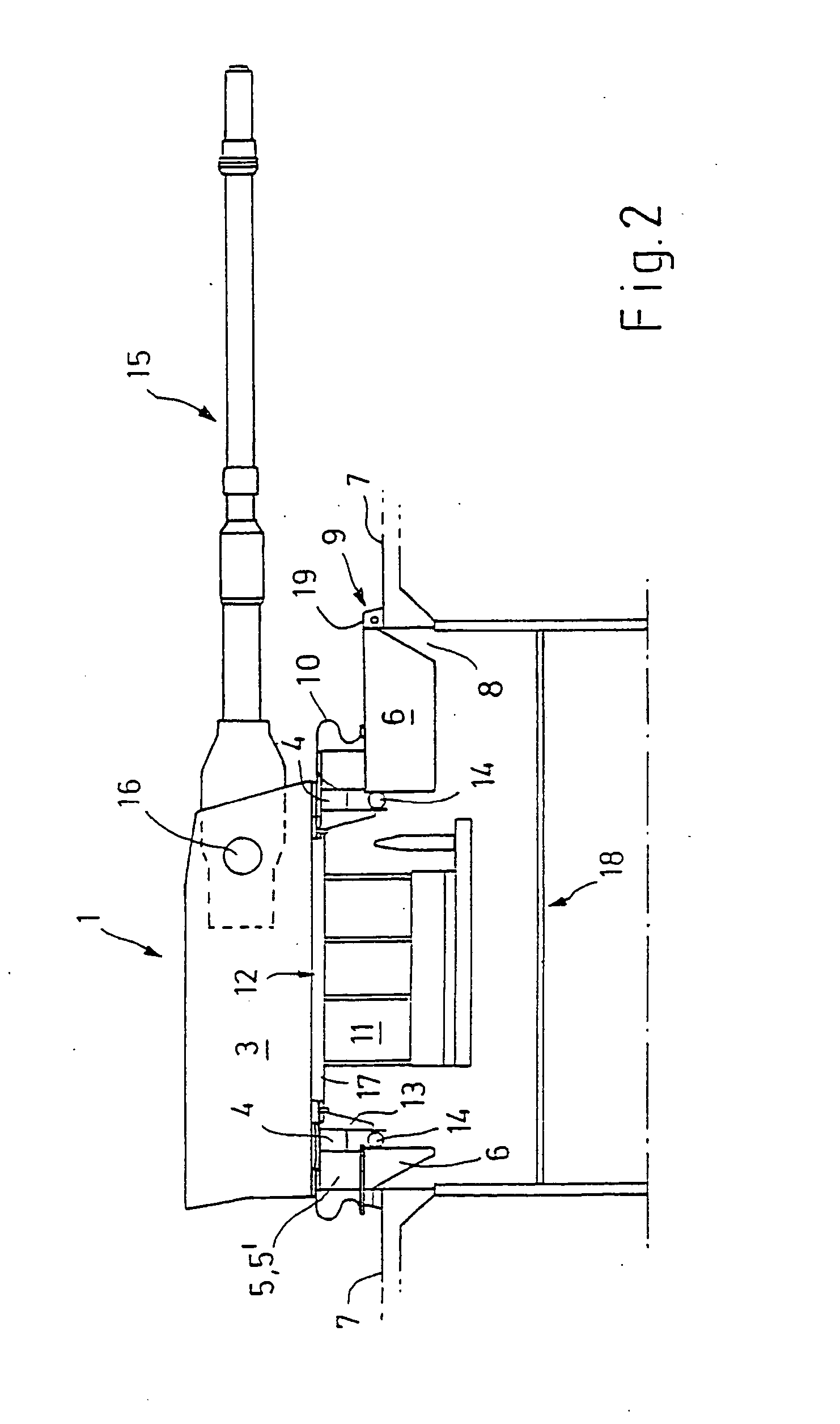[0008] The object of the invention is to satisfy the existing military requirements for provision of the capability for naval fire support (NFS) for the use of military ships in the coastal area, with fire support for amphibious operations being of particular importance in this context, for which purpose the
projectile range should be considerably increased so that it is also possible to
attack inland targets with a high hit accuracy. The aim is to achieve this object for newly built ships and during ship conversions without any major modifications to the steel structure and with as little financial cost and time penalty as possible.
[0010] The invention is based on the knowledge that the use of land guns on ships, which has not been possible until now, satisfies the new naval requirement by the use of existing technology, which even exceeds expectations, rather than by expensive new development. The use of the land guns with a caliber of >127 mm on a ship advantageously makes it possible to use the proven technology of large-caliber land guns for newly built ships. In a further advantageous manner, the
turret of a land gun can be connected to an adaptor plate and a shock-absorbing mounting and can be installed on the ship in such a way that the existing steel structure of the ship withstands the increased recoil forces. It is particularly simple for this installation to be in a modular form, so that no significant modifications need be made to the ship, and the installation can be carried out in a short time. Land guns with a caliber of >127 mm can be used without modification, with the recoil forces to be transmitted to the gun
deck being absorbed in a particularly advantageous manner by a shock-absorbing mounting so that the advantageous
adaptation (which can be produced in a technologically simple manner) and refinement of the adaptor plate and additional shock damping for the gun
deck allows the ship technology standard to be linked to the land technology standard, with this new naval requirement being covered by existing land guns, preferably from the armored 155 mm howitzer, rather than by expensive new development.
[0011] The modular (for example) use of the turret and of the
weapon system from the armored 155 mm howitzer as a ship gun makes it possible in a particularly advantageous manner to achieve a long range and
high effectiveness on the target with little scatter. The gun according to the invention can also advantageously carry intelligent submunitions, for example cluster munitions or
smoke munitions. In the coastal area, the use of a turret with a
weapon system from the armored 155 mm howitzer as a ship gun allows fire support for land operations from a safe position with an advantageous range of >40 km. In a further advantageous manner, the modular installation of the armored howitzer on the ship can be sealed such that it is NBC-proof by the use of a radial
damper, thus preventing any danger to the operator.
[0012] When the armored 155 mm howitzer is used as a ship gun, the recoil forces must be reduced. A shock-absorbing, elastic mounting results in the introduction of the force being extended over time, thus resulting in technically acceptable residual accelerations for the ship
deck. Despite the use of this elastic mounting, an attitude reference arranged above the elastic mounting on the gun guarantees correct target aiming. This attitude alignment is made possible by arranging an
inertial platform with GPS and
satellite navigation on the turret, which is used to determine the three-dimensional position of the weapon
barrel and the geographical position on the earth, thus avoiding the disadvantages of the ship-related influences on previous ship guns. For the reason mentioned above, the invention now allows shots to be fired from a moving ship at a moving target.
[0013] The long range allows the ship to be further away from the land, thus making it considerably more difficult to find the position of the ship. In contrast, land targets can easily be located from the ship by means of helicopters and drones. The invention also advantageously allows the use of projectiles with submunitions, as a result of which, when bomblets are used, it is in any case possible to
attack targets without requiring 100% exact target coordinates, which represents a particular
advantage for attacks from ships at sea. In a further advantageous manner, the invention allows the combat range for seaborne targets at sea to be doubled. The proven,
intelligent sensor system of the armored howitzer allows the turret to always be newly aimed even though the ship is continuing to move. The high aiming accuracy results in a considerable reduction in the number of shots to be fired. The use of the turret and the
weapon system from the armored 155 mm howitzer results in ammunition compatibility between the various land and seaborne armed forces units. In future, the invention will also allow naval ships to attack targets well in land, with the use of intelligent (sub-) munitions also being possible.
 Login to View More
Login to View More  Login to View More
Login to View More 


